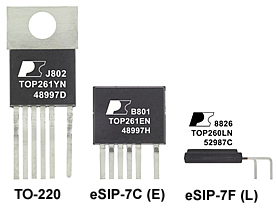eSIP Package Information
eSIP™ Package Enables Simpler, Lower Profile Power Supplies
Power Integrations' new eSIP package has the same low thermal impedance as the traditional TO-220, yet it's only half the height. This is ideal for slimmer electronic products such as LCD monitors, flat screen TVs, and set-top boxes.
Mounting Options
There are multiple low-cost mounting options for the eSIP package.
eSIP benefits:
- Reduced height of package allows lower profile designs
- Similar junction-to-case thermal impedance (θJC) as standard TO-220 package
- Heat slug connected to Source to reduce EMI noise
- Simple clip-mounted heatsink reduces manufacturing cost and improves repeatability
For specific information on package dimensions, please see Power Integrations' Package Information Document.
|
Figure 1 (right) illustrates the height difference between some of the packages shown in the above table. The L version of the eSIP, mounted with the adhesive mounting compound, has the lowest mounting height of 2.1 mm. The E version of the eSIP, mounted with the same compound, also has a very low profile (10.5 mm) when compared to the TO-220. |
 Figure 1: eSIP E and L packages with TO-220 |
Package Comparison
|
Package
|
Mounting Method
|
Minimum Mounted Height
|
Heatsink Potential
|
|---|---|---|---|
|
eSIP (L)
|
Liquid Adhesive
Tape |
2.1 mm
2.1 mm |
Source
|
|
eSIP (H)
|
Extended Plastic Clip
|
10.5 mm
|
N/A
|
|
eSIP (E)
|
Liquid Adhesive
Tape U-Clip Plastic Mini Clip Metal Clip Plastic Clip |
10.5 mm
10.5 mm 15.1 mm 20 mm 20 mm 24 mm |
Source
|
|
TO-220 (PI)
|
Liquid Adhesive
Tape Screw |
21 mm
21 mm 21 mm |
Source
|
|
TO-220 (Standard)
|
Liquid Adhesive
Tape Screw |
21 mm
21 mm 21 mm |
Drain
|
NOTE: The Power Integrations TO-220 and eSIP packages feature an exposed lead frame. This lead frame is connected to the SOURCE terminal of the MOSFET power device. When mounted, it is also connected to the heatsink. This ensures that the heatsink is connected to the DC(-) rail, which is also the electrically quiet node, and therefore does not lead to an increase in radiated EMI.


